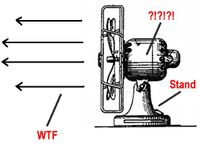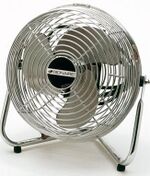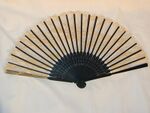Mechanical fan
Mechanical Fans are wondrous contraptions which when activated spontaneously "create" wind. No one is quite sure how this is done, and it is a mystery that has baffled scientists for years, but the mechanical fan is a celebrated device worldwide, with the exception of countries which have a consistently cold climate, such as Alaska or Russia.
When thinking of mechanical fans, some people can confuse them with robotic fans (specially designed artificial intelligence droids whose job is to praise their owners every move).
History[edit]
The history of the mechanical fan starts in England, in the Middle Ages. At the time the only way to produce wind at will was very tiresome and awkward. Hand held fans were used at the time, and whilst they could cool people down quite well, the constant waving of the hand caused fatigue in many people, and sometimes even injury. 67% of people who used hand held fans in the middle ages broke or fractured at least one bone in their wrist during this period.
The hand held fan was far from ideal, and so in the year 1502 Leonardo Da Vinci came forward and proposed a new method to produce wind. He had spent many years of his life making blue prints for what he called the "Per Fare é Popcorn" Which in English translates to "Wind Creator". Unfortunately for Leonardo, his idea was criticized as been silly and outrageous, and his invention stayed on paper for years, until the 1930's, when his blueprints were rediscovered and used by an unknown person (who we presume to be a male due to the undeniable fact that males invented everything worthwhile) who built the mechanical fan we know and love today.
The Modern Fan And How It Works[edit]

The 1930's onwards saw a sharp increase in the number of mechanical fans, going from 1 to 300 billion over a period of 70 years. It is still increasing today. It is not known where they come from or who is making them, people are just happy to have them. They have evolved over the years to be used in many other things. They are in computers, cars, planes, trains, automobiles and on the ceilings of fancy restaurants. They are everywhere. It has been statistically proven that everyone is always no less than 2 meters away from a fan, unless you are in the Gobi desert or some other desolate place, in which case the statistics change slightly.
But with all this dependence on mechanical fans in the modern world, it is still unknown how they work, as the diagram to the right illustrates. Just where is that wind coming from. Some have theorized that the giant motor which spins rapidly in the middle of the fan is the causing the air around it to move making it appear to be windy. Others have dismissed this theory as unrealistic and claim that the motor is powering something inside the fan which rips a hole in space-time, borrows air from a parallel universe where it is always windy, before projecting it into our dimension. There are many conflicting theories.
Hopefully an experiment due to start in late 2009 may shed light on the mystery. When the LHC (Large Hardon Collider) powers up, its results could lead to the discovery of the theorized "windy" dimension, or not. Either way, one theory shall be proved right or wrong.

